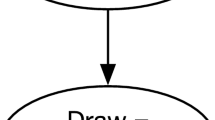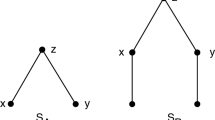Conclusion
The analyses of explanation and causal beliefs are heavily dependent on using probability functions as models of epistemic states. There are, however, several aspects of beliefs that are not captured by such a representation and which affect the outcome of the analyses.
One dimension that has been neglected in this article is the temporal aspect of the beliefs. The description of a single event naturally involves the time it occurred. Some analyses of causation postulate that the cause must not occur later than the effect. If we want this kind of causality it is easy to add the appropriate clause to (CAUS). An alternative is not to rule out backwards causation or causal loops a priori, but expect that (CAUS), via the properties of the contraction P -C , will result in the desired temporal relation between C and E. One way of ensuring this is to postulate that when the probability function P is contracted to P -C , the probabilities of all events that occurred before C remain the same in P -C as in P. This means that all beliefs about the history of events up to C are left unaltered in the construction of the hypothetical state of belief P -C .
In conclusion, I hope to have shown that, in spite of these limitations, (EXP) and (CAUS) provide viable analyses of explanation and causality between single events for the case when epistemic states can be described by probability functions. I have also shown that the two analyses can be used to explicate the close connections between the two notions. These analyses reduce the problems of explanation and causality, hopefully in a non-circular way, to the problem of identifying contractions of states of belief.
Similar content being viewed by others
Bibliography
Alchourrón, C. E., Gärdenfors, P., and Makinson, D. (1985): “On the logic of theory change: Partial meet contraction and revision functions”, Journal of Symbolic Logic 50, 510–530.
Aristotle (1975): Posterior Analytics, translated with notes by J. Barnes (Oxford: Clarendon Press).
Beauchamp, T. L. and Rosenberg, A. (1981): Hume and the Problem of Causation (Oxford: Oxford University Press).
Dray, W. (1957): Laws and Explanation in History (Oxford: Oxford University Press).
Gärdenfors, P. (1976): “Relevance and redundancy in deductive explanations”, Philosophy of Science 43, 420–431.
Gärdenfors, P. (1979): “Conditionals and changes of belief”, in The Logic and Epistemology of Scientific Change, I. Niiniluoto and R. Tuomela, eds. (Amsterdam: North-Holland), 381–404.
Gärdenfors, P. (1980): “A pragmatic approach to explanation”, Philosophy of Science 47, 404–423.
Gärdenfors, P. (1981): “An epistemic approach to conditionals”, American Philosophical Quarterly 18, 203–211.
Gärdenfors, P. (1982): “Rules for rational changes of belief”, in Philosophical Essays Dedicated to Lennart Åqvist on his Fiftieth Birthday, T. Pauli, ed. (Department of Philosophy, Uppsala).
Gärdenfors, P. (1986): “The dynamics of belief: Contractions and revisions of probability functions”, Topoi 5, 24–37.
Gärdenfors, P. (1988a): Knowledge in Flux: Modeling the Dynamics of Epistemic States (Cambridge, MA: Bradford Books, MIT Press).
Gärdenfors, P. (1988b): “Causation and the dynamics of belief”, in Causation in Decision, Belief Change and Statistics II, W. L. Harper and B. Skyrms, eds. (Dordrecht: Kluwer), 85–104.
Good, I. J. (1961–2): “A causal calculus I–II”, British Journal for the Philosophy of Science 11, 305–318, and 12, 43–51.
Granger, C. W. J. (1969): “Investigating causal relations by econometric models and crosspectral methods”, Econometrica 37, 424–438.
Granger, C. W. J. (1988): “Causality testing in a decision science”, in Causation, Chance and Credence, B. Skyrms and W. L. Harper, eds. (Dordrecht: Reidel), 3–21.
Hansson, B. (1975): “Explanations - Of what?” (manuscript, Department of Philosophy, Stanford University).
Harper, W. L. (1978): “Bayesian learning models with revision of evidence”, Philosophia 7, 357–367.
Hempel, C. G. (1962): “Deductive-nomological vs. statistical explanation”, in Minnesota Studies in the Philosophy of Science 3, H. Feigl and G. Maxwell, eds. (Minneapolis: University of Minnesota Press), 98–169.
Hempel, C. G. (1965): Aspects of Scientific Explanation (New York: Free Press).
Hempel, C. G. (1968): “Maximal specificity and lawlikeness in probabilistic explanation”. Philosophy of Science 35, 116–134.
Hesslow, G. (1976): “Two notes on the probabilistic approach to causality”, Philosophy of Science 43, 290–292.
Hume, D. (1748): An Enquiry Concerning Human Understanding (London).
Keynes, J. M. (1921): Treatise on Probability (London: Macmillan).
Levi, I. (1977): “Direct inference”, The Journal of Philosophy 74, 5–29.
Levi, I. (1988): “Four themes in statistical explanation”, in Causation in Decision, Belief Change, and Statistics II, W. L. Harper and B. Skyrms, eds. (Dordrecht: Reidel), 195–222.
Lewis, D. (1973): “Causation”, Journal of Philosophy 70, 556–567.
Lewis, D. (1976): “Probabilities of conditionals and conditional probabilities”, Philosophical Review 85, 297–315.
Mackie, J. L. (1974): The Cement of the Universe (Oxford: Oxford University Press).
Pizzi, C. (1988): “Causal preemption and iterated conditionals”, in Temi e prospettive della logica e della filosofia delta scienza contemporanee 2, (Bologna: CLUEB) 129–132.
Popper, K. R. (1968): The Logic of Scientific Discovery, revised edition (London: Hutchinson).
Reichenbach, H. (1956): The Direction of Time (Berkeley).
Rott, H. D. (1982): “Gärdenfors' epistemologische Explikation wissenschaftlichen Erklärung” (manuscript, Seminar für Logik und Wissenschaftstheorie, Universität München).
Salmon, W. C. (1971): Statistical Explanation and Statistical Relevance (Pittsburgh: University of Pittsburgh).
Salmon, W. C. (1980): “Probabilistic causality”, Pacific Philosophical Quarterly 61, 50–74.
Schurz, G. (1983): Wissenschaftliche Erklärung (Dissertation, Karl-Franzens-Universität, Graz).
Scriven, M. J. (1959): “Explanation and prediction in evolutionary theory”, Science 130 (no. 3374), 477–482.
Sintonen, M. (1984): The Pragmatics of Explanation (Amsterdam: North-Holland).
Spohn, W. (1983a): “Deterministic and probabilistic reasons and causes”, Erkenntnis 19, 371–396.
Spohn, W. (1983b): “Probabilistic causality: from Hume via Suppes to Granger”, in Causalità e modelli probabilistici, M. C. Galavotti and G. Gambetta, eds. (Bologna: CLUEB).
Stegmüller, W. (1983): Erklärung, Begründung, Kausalität, second edition (Berlin: Springer-Verlag).
Suppes, P. (1970): A Probabilistic Theory of Causality (Amsterdam: North-Holland).
Teller, P. (1976): “Conditionalization, observation and change of preference”, in Foundations of Probability Theory, Statistical Inference, and Statistical Theories of Science 1, W. L. Harper and C. H. Hooker, eds. (Dordrecht: Reidel).
van Fraassen, B. (1977): “The pragmatics of explanation”, American Philosophical Quarterly 14, 143–150.
van Fraassen, B. (1980): The Scientific Image (Oxford: Clarendon Press).
Vercelli, A. (1986): “Probabilistic causality and economic models: Suppes, Keynes, Granger”, Quaderni dell'Istituto di Economica (Siena: Universitá degli Studi di Siena).
Author information
Authors and Affiliations
Rights and permissions
About this article
Cite this article
Gärdenfors, P. An epistemic analysis of explanations and causal beliefs. Topoi 9, 109–124 (1990). https://doi.org/10.1007/BF00135892
Issue Date:
DOI: https://doi.org/10.1007/BF00135892




